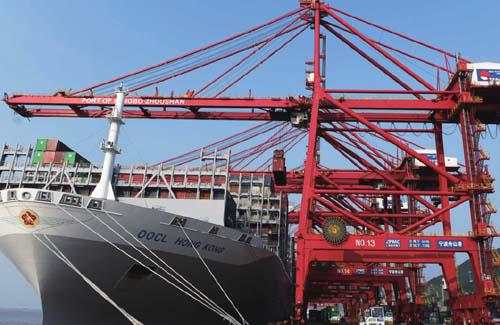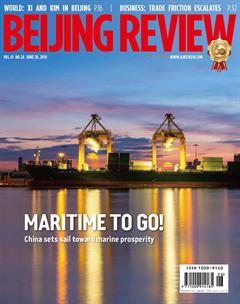On the Rise
By Deng Yaqing


On June 13, the U.S. Federal Reserve raised its benchmark federal funds rate as expected by a quarter of a percentage point to a range of 1.75 to 2 percent, marking the second interest rate increase this year.
“The move was a response to market expectations,” E Yongjian, a senior analyst with the Bank of Communications, told Xinhua News Agency, noting that the lifting of the interest rate was widely anticipated prior to the announcement.
E attributed the increase to improving economic fundamentals in the United States, particularly the job market. In May, the countrys non-agricultural unemployment rate fell to 3.8 percent, an 18-year low, with the infl ation rate hovering around the set target of 2 percent.
At a press conference on June 14, Mao Shengyong, spokesperson for Chinas National Bureau of Statistics, said that the Federal Reserves move is to some extent in line with market expectations and therefore part of the impact has already been mitigated.
“Reviewing Chinas past experiences and conditions, one will find that the impact of the Federal Reserves interest rate hike on the Chinese economy is limited,” said Mao.
Independent policy choice
The day after the news, the Peoples Bank of China (PBC) pumped 70 billion yuan ($10.76 billion) into markets through 7-day, 14-day and 28-day reverse bond repurchase agreements, with the reverse rate to be paid at 2.55 percent, 2.70 percent and 2.85 percent respectively, unchanged from previous levels, suggesting that Chinas central bank was not going to follow the Federal Reserves lead in raising interest rates.
Wen Bin, chief researcher with China Minsheng Bank, told the 21st Century Business Herald that there are two reasons behind the PBCs decision.
“Liquidity is usually tight in June, and ensuring the stability of liquidity is essential to sound economic growth. Furthermore, recent fi nancial and macroeconomic statistics show a slow- down in consumption and investment, and a contraction of total social fi nancing,” Wen said.
In May, total social financing, a broader measure of new credit in the economy, grew by 760.8 billion yuan ($116.97 billion), a decrease of 51 percent from April and the lowest for 22 months. Additionally, from January to May, fi xed assets investment increased by just 6.1 percent year on year, the lowest since 2000, while total sales of consumer goods grew by 8.5 percent, the lowest since June 2003.
This is not the fi rst time that Chinas central bank has chosen not to take responsive action to the raising of interest rates by the Federal Reserve, with the same scenario playing out last June. With the exception of these two instances, the PBC has traditionally responded by lifting the interest rate of the Medium-term Lending Facility (MLF) on the same day the Federal Reserve increased the federal funds rate.
“Chinas monetary policy is more con- cerned with domestic conditions,” Ming Ming, a senior analyst with CITICS Securities, told Xinhua News Agency, explaining that Chinas decision on whether or not to raise interest rates depends on both internal and external factors.
Currently, the gap between the interest rates of the United States and China is a mere 0.7 of a percentage point, which is still within the normal range. Market expectations for yuan devaluation are declining and funds outstanding for foreign exchange have been on the rise for five consecutive months, which further relieve the necessity to lift interest rates for the time being, said Ming.
At home, financial supervision and deleveraging efforts are continuing and commercial banks off-balance-sheet, nonstandard financial assets are experiencing a dramatic reduction. In addition, the slowdown of total social financing has put pressure on the real economy, Ming said.
“There is still a gap between the openmarket operation interest rate and the market interest rate. Thats to say, an interest rate rise will not have a significant impact on the market,” noted E, adding that the central bank also took into consideration the contraction of total social fi nancing, hoping to maintain stable liquidity.
From the macroeconomic perspective, there is still room for adjustment in Chinas monetary policy, said Wen. Stable overseas market demands, robust real estate investment and good performance in industrial added value growth may shore up the countrys GDP to maintain the pace of growth registered in the fi rst quarter.
Potential impact
As the Federal Reserve speeds up the increase of interest rates, the currencies of emerging economies could begin to face greater pressure.
In fact, before the recent hike, emerging economies such as Argentina, India and Indonesia had been left in the lurch by the Federal Reserves quick steps. Argentinas central bank raised its interest rate three times within eight days to 40 percent. The Turkish lira tumbled by 20 percent and the interest rate was raised twice within half a month to 17.75 percent, while fi nancial markets in Brazil, Indonesia and Mexico experienced their own turbulent conditions.
For emerging economies, especially those with heavy dollar liabilities and a large trade deficit, the risk of currency depreciation forces them to raise interest rates in step with the Federal Reserve, said Wen, suggesting that the faster the Federal Reserve moves, the greater risks these emerging countries will face.
E believes that the accelerated raising of interest rates represents confidence in the long-term positive development of U.S. economic fundamentals. Notwithstanding uncertain factors, the U.S. economy will take on stronger growth momentum than the eurozone and Japan, and thus the Federal Reserve will in turn further hasten its pace in rate hikes.
Some experts worry that China could suffer from capital fl ight and an increase in leverage if it does not keep pace with the Federal Reserve. “Now, no matter in terms of direct investment or capital account, there is a balance of two-way fl ow. Chinas macro economy, asset price and exchange rate are now relatively stable,” said Wen.
In the future, attention should be paid to both the domestic and overseas environments, including the European Central Banks monetary policy and whether the Federal Reserve will hike its interest rate four times this year, Wen noted, suggesting that the best policy China can adopt may be raising interest rates and lowering the long-term cost of capital through reserve requirement ratio cuts.

